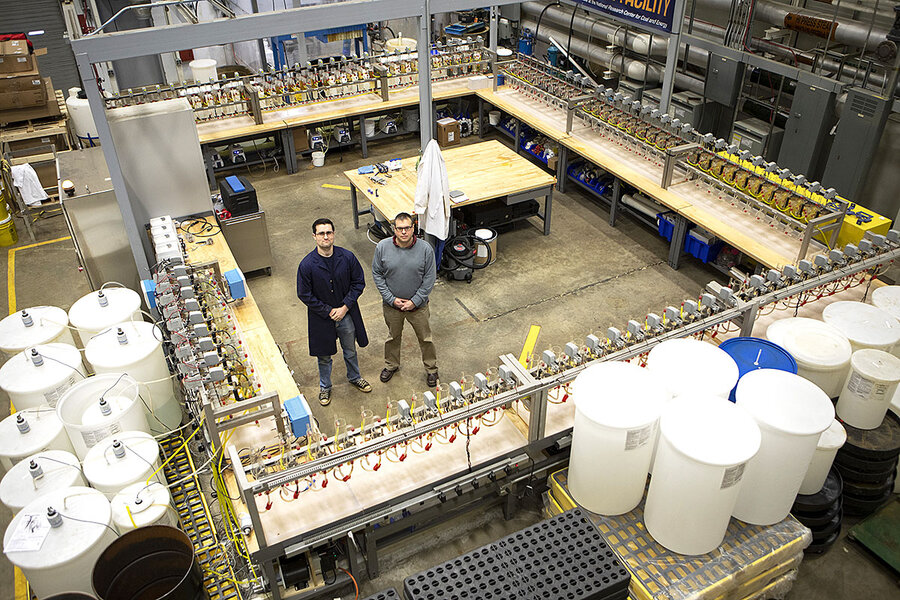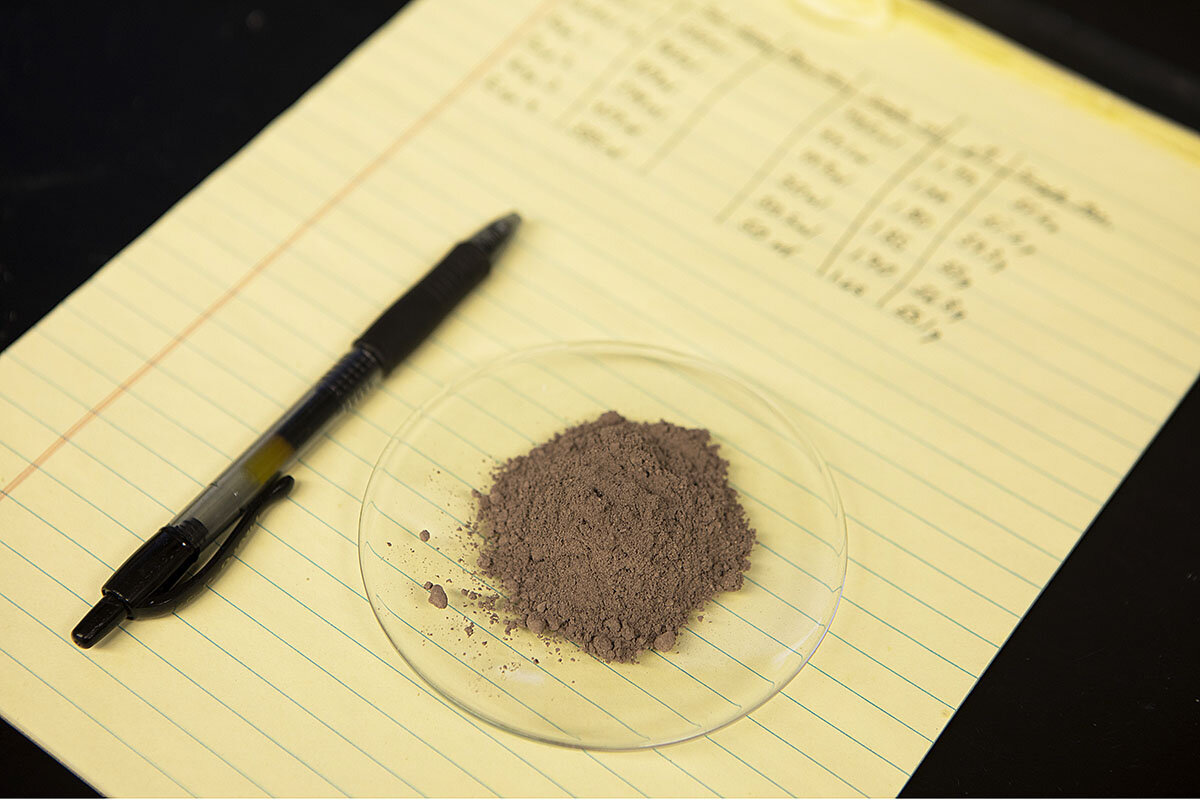How coal mine waste could help build your next phone
Loading...
| Morgantown, W.Va.
For years, U.S. companies and the military have worried about their reliance on China for key minerals used in everything from smartphones and electric cars to satellites. These 17 minerals, called rare-earth elements, sit at the bottom of the periodic table, with strange names like scandium and yttrium.
Now a project near Mt. Storm, West Virginia, aims to change the supply equation – by extracting rare earths from mining runoff. If it works at a viable price, the process would incentivize companies to clean up waters and streams, while also filling a strategic gap for the United States.
Why We Wrote This
For years it’s been a fact of life – and a source of strategic worry – that China has a lock on certain minerals vital to high-tech industries. The work of one U.S. lab raises the question, what if the sense of scarcity is unfounded?
In a cavernous lab, dozens of glass containers filter the mine drainage. The end result is a handful of tan powder with the rare earths. Work remains to be done to efficiently separate those minerals from one another.
“We think it’s going to be much more competitive than opening a brand new hard rock mine,” says Paul Ziemkiewicz, the West Virginia University researcher who discovered the link between acid mine drainage and rare-earth metals. “There really isn’t a domestic supply chain for rare earths.”
Near Mt. Storm, West Virginia, a pilot plant under construction will soon test a potential win-win for industry and the environment.
It aims to turn a major pollutant of streams and ponds – acid mine drainage – into badly needed minerals for everything from smartphones and electric cars to jet fighters and satellites.
If it works, at a price that can earn companies a profit, the process would provide a major incentive for companies to clean up waters and streams, cut costs for the mining industry, and plug a strategic hole for the United States, which currently imports most of those minerals from China.
Why We Wrote This
For years it’s been a fact of life – and a source of strategic worry – that China has a lock on certain minerals vital to high-tech industries. The work of one U.S. lab raises the question, what if the sense of scarcity is unfounded?
“We think it’s going to be much more competitive than opening a brand new hard rock mine,” says Paul Ziemkiewicz, director of the West Virginia Water Research Institute here at West Virginia University, and the researcher who discovered the link between acid mine drainage and rare-earth metals. “There really isn’t a domestic supply chain for rare earths.”
For years, U.S. companies and the military have worried about their reliance on China for rare earths. These are 17 elements, sitting at the bottom of the periodic table, with strange names like dysprosium, scandium, and yttrium. These metals are key for the manufacture of smartphones, advanced batteries, ceramics, satellite communications, and magnets used in everything from hard drives to antilock brakes. Some 80% of U.S. imports come from China.
And China has sometimes used that dominant position to sharply reduce its supply to nations (like Japan, temporarily, in a 2010 dispute) and threatened obliquely last year to do so again, this time against the U.S. in the middle of the trade war.
In 2014, the U.S., Japan, and the European Union won a World Trade Organization case against Beijing after it sent the average price of rare earths soaring nearly 25-fold. China also may have restricted access to rare earths to foreign manufacturers unless they produced their goods in China and shared their technology with a domestic partner, according to a 2019 report by the Congressional Research Service.
“China’s domination of the rare earth element market illustrates the potentially dangerous interaction between Chinese economic aggression guided by its strategic industrial policies and vulnerabilities and gaps in America’s manufacturing and defense industrial base,” said a 2018 report by the U.S. Defense Department and other federal agencies.
Now, Dr. Ziemkiewicz and his team in West Virginia are trying to change that strategic balance. In a cavernous laboratory, dozens of glass containers with miniature mixers in each one filter the acid mine drainage to create a greater and greater concentration of rare-earth metals. For all the impressive infrastructure, the end result is a handful of tan powder, like cocoa.
To test if the process can deliver commercial-sized quantities of the metals, the team has won a $5 million award from the U.S. Department of Energy to build the pilot plant near Mt. Storm in partnership with the West Virginia Department of Environmental Protection and two companies. If it works, Dr. Ziemkiewicz estimates the acid mine drainage in West Virginia, Pennsylvania, Maryland, and Ohio alone could yield annually up to 2,200 tons of rare-earth elements, more than three times what the U.S. produced last year. The nation has up to 500,000 abandoned mines.
“This is a green, green solution,” says Tom Stephens, commercial director of TenCate Geosynthetics Americas, one of the partner companies in the project.
Mining operations or any large disturbance of land, such as a construction project, often create deposits of rock and waste that can leak an acidic runoff that kills fish and plant life in ponds and streams. The continued ingestion of water or fish contaminated by that runoff has been linked to health problems for humans. Since the late 1970s, coal mines have been responsible for cleaning up that water. If mine companies can make money from that process by selling concentrates of rare earths, then it would at a minimum reduce their cleanup costs and, possibly, eliminate them, giving companies an incentive to clean up acid mine drainage.
When West Virginia mines are abandoned, the state picks up the job, using a fund paid for by the mining companies. “If we can recoup some of the money that we are using it would be a huge benefit,” says Mike Sheehan, deputy director for reclamation programs at the state Department of Environmental Protection. The state is currently spending some $3.5 million a year to treat 254 contaminated sites.
Even if the pilot project shows promise, there is one more hurdle. The researchers still have to figure out a way to separate out the individual rare-earth minerals from the powder.
“We have a piece of it, but we haven’t connected the dots,” says Paul McRoberts, industry manager for North America for Rockwell Automation, the project’s other commercial partner. “The current government seems to be very interested in figuring out that missing link.”
It was a government request that sparked the original idea of using acid mine drainage to create rare-earth metals.
“I hadn’t given rare earths much thought,” says Dr. Ziemkiewicz, who had made a career of researching how to mitigate acid mine drainage. But when the National Energy Technology Lab sent out a request for proposals in 2015 on how to use coal byproducts to make rare earths, he had an inspiration. Sure enough, old data showed that the rare earths existed in the runoff, and he and his team have found a way to precipitate them out.
His team isn’t the only one working on making rare earths from mining operations. In Colorado, USA Rare Earth LLC and Texas Mineral Resources Corp. have announced they plan to open a pilot plant this quarter to separate and purify rare-earth metals from a Texas deposit.
“Our advantage with AMD [acid mine drainage] is that 45 to 50% of the rare earths present are heavy rare earths,” typically the most valuable, Dr. Ziemkiewicz says.










